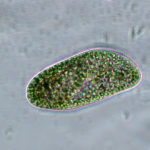Johan Decelle, researcher at the Cell & Plant Physiology Laboratory, is exploring the metabolic basis of
photosymbiosis* in freshwater and marine unicellular models in order to understand how this partnership works. His team aims to unveil the subcellular mechanisms that play a key role in the maintenance of photosymbiosis. By combining transcriptomics and metabolomics, the team uses different imaging techniques at the nanoscale, such as 3D electron microscopy and chemical imaging platforms.
The two models of single-cell photosymbiosis studied in Johan's team:
|
In Freshwater habitat | |
In the Ocean |

| |

|
| The freshwater symbiosis between the ciliate Paramecium bursaria and the green alga Chlorella spp. | | The marine symbiosis between radiolarians and haptophytes or dinoflagellates microalgae.
|
Photosymbiosis: Symbiosis between heterotrophic hosts and microalgae (photosymbiosis) is a widespread and ecologically important phenomenon in aquatic ecosystems. Although knowledge of the diversity of symbiotic partners has improved in recent years, the underlying mechanisms and metabolic interactions remain poorly understood.
Single-celled marine plankton, that sustain oceanic food webs and strongly impact the global carbon cycle, can establish various kinds of symbioses to gain energy. Plastid symbiosis, whereby host cells temporarily integrate microalgal cells (photosymbiosis) or just their photosynthetic plastids (kleptoplastidy) as intracellular solar-powered carbon factories, is a key interaction in worldwide surface oceans. Plastid symbiosis was at the origin of a major evolutionary innovation that spread photosynthesis across eukaryotes, transforming the biosphere. Despite this ecological and evolutionary importance, very little is known about how a photosynthetic machinery is structurally and metabolically integrated into a host cell and what mechanisms allow cells to transport sugars, the main photosynthetic product and energetic currency.
"We will develop novel imaging and genetic tools to mechanistically dissect this key metabolic interaction at different scales." explains Johan. "Combining multimodal subcellular imaging and photophysiology, we will first unveil how the photosynthetic machinery is morphologically and metabolically remodeled in symbiosis to provide benefits to the host. We will then investigate the identity, localization and role of sugar transporters underlying the source-sink carbon flux in plastid symbiosis, providing the basis to evaluate the evolutionary and environmental forces that shape the metabolic connection".
Crossing boundaries between structural biology, eco-physiology and evolution, this ambitious project will resolve fundamental mechanisms in widespread planktonic symbioses, advancing our understanding of the functioning and carbon flux of marine ecosystems.